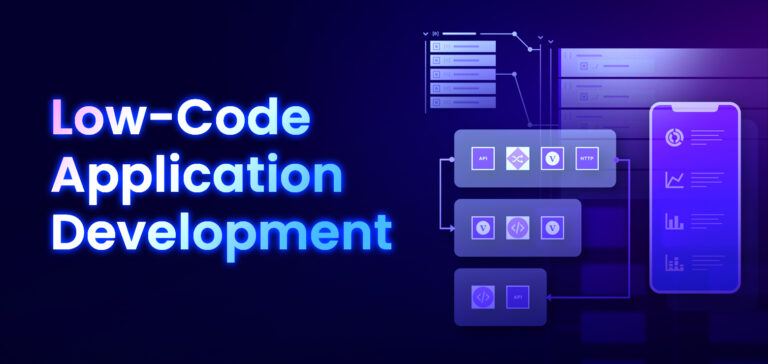Benefits Of Low-Code Application Development In Terms Of Accessibility For Non-Developers
The following key factors make low-code development accessible to non-developers.
Drag-and-Drop Builders: Low-code platforms have drag-and-drop interfaces that enable non-developers to build applications without needing to write code. The process of developing applications is now more accessible to those with no technical background.
WYSIWYG Editors editors "What You See Is What You Get" editors assist users in creating workflows and interfaces that appear like the final products, making them more understandable.
Simplified Design of Logic and Workflow
Visual Workflow Modeling: Users may develop business processes and apply logic through visual flowcharts and models that are more user-friendly than conventional coding techniques.
Low-code platforms usually include pre-built logic components (e.g., conditional statements, loops) that can be easily set up, reducing the need for complex coding.
Reusable Components & Templates
Library of Pre-built Templats Many Low-Code platforms have templates based on common application types. Non-developers are able to customize the templates as needed.
Reusable Widgets and Modules: Users can make use of reusable widgets and modules to streamline the process of creating them and reducing the need for technical knowledge.
Guided Development Tutorials and Guided Development
Step-by-Step Guides: Platforms often offer a set of development guides, tutorials, and on-screen guidelines to assist novice developers in developing applications.
Interactive Tutorials Interactive tutorials are interactive and hands-on that allow users to learn by doing. This increases the confidence of users in the platform.
Integration with existing tools:
Seamless Integration: Low-code platforms have been built to easily integrate with the existing business tools and systems (e.g. CRM, ERP ERP, CRM), allowing non-developers to build applications that fit with their existing workflows.
APIs and Connectors: Built-in APIs and connectors ease the integration process by allowing non-developers to connect their applications to external services without the need for complicated coding.
Collaboration Features:
Team Collaboration: Features such as real-time collaboration, as well as shared workspaces allow non-developers to collaborate with professionals, business analysts and other stakeholder groups effectively.
Access control based on role: Role levels can be set for people who aren't developers to ensure they can still contribute to the development process, but without compromising the security.
Automated Testing and Debugging
Low-code platforms usually come with debugging and testing software that can automatize these procedures. This makes it simpler for non-developers to check their applications work correctly.
Error Highlighting: Whenever issues arise the platform highlights any errors and suggests fixes, guiding non-developers through troubleshooting steps.
The capability of low-code apps to make development accessible to non-developers is their biggest benefit. Low-code platforms allow business users to participate actively in the development and maintenance of apps by offering visual tools and a guided user experience. This bridges the gap between the technical implementation and business demands. Check out the recommended Low-code Platform for application development tips for website advice including develop web app, database in azure, azure sql server, cross platform app dev, multiplatform mobile app development, sso azure, application modernization, rapid action development, push alerts, app development platform and more.

Benefits Of Low-Code Application Development In Terms Of Scalability And Flexible
Low-code application development has many advantages in terms of the ability to scale and flexibility. These are crucial for building applications that grow with business needs and be able to adapt to the changing demands. These are the major benefits: Rapid Scaling:
Cloud-Based Deployment: Many low-code platforms are cloud-based which allows applications to grow seamlessly with the underlying cloud infrastructure. This allows businesses handle increased workload without having to manage servers.
Auto-Scaling: This feature will automatically adjust the resources according to the demand. This ensures constant performance during peak times, without any manual intervention.
Flexible Architecture:
Modular Design: Low-code platforms promote the modular design of applications, allowing components to be independently designed, tested and scalable. This is a fantastic way to enhance flexibility. It also makes it easy to upgrade and expand components of an application without having to have the whole application affected.
Microservices Integration : Supporting microservices architecture, applications can be built using loosely-coupled services to enhance the flexibility and scalability.
Customizable Solution:
Extensibility: Low-code platforms usually permit custom programming and scripting, allowing developers to extend the functionality of the applications beyond what is available out-of-the-box. This allows unique business requirements to be met without limitations.
Third-Party Integrations: The capacity to connect with third-party services and APIs allows companies to integrate additional features and services and enhance the capabilities of the application.
Agile Development and Deployment
Continuous Delivery and Deployment Low-code platforms support agile methods that allow continuous integration and continuous delivery (CI/CD). This enables rapid deployment of features and updates. The applications can grow rapidly in response to market developments and feedback from users.
Iterative Design: Since low-code is an iterative procedure the applications can be gradually improved and enlarged. This allows for controlled growth, and minimizes the risks associated with large-scale modifications.
Resource Optimization:
Low-code platforms provide tools to analyze and monitor the performance of applications, which helps maximize the utilization of resources. This ensures resources are used effectively and can be scaled according to the needs of the user.
Load Balance: This function allows the application to handle heavy traffic by distributing workloads across several servers. It also ensures performance is consistent.
Global Reach
Multi-Region Deployment: Low-code platforms often support deployment across multiple geographical regions, allowing businesses to provide low-latency services to users around the world. This is especially important when applications are popular with a worldwide user base.
Localization Support. Built-in support to localize applications makes them easily modified to other local languages, regional needs and increases their flexibility across different markets.
Maintenance and Updates
Simple Maintenance: The aesthetic and modular design of low-code software simplify maintenance tasks, allowing bugs and updates to be made quickly, without lengthy downtime.
Version Control: The integrated versions control systems permit the secure deployment of updates and rollbacks. Versions from the past can be restored in case they're required.
Cost Efficiency:
Lower Development Costs: By cutting down on the need for a lot of code, low-code platforms cut down on development costs and enable to scale apps without a proportional increase in development effort and expense.
Pay-As-You-Go Models: Many low-code services offer a variety of pricing models, like pay-as-you-go, which align costs with use and growth, offering financial flexibility.
In general, low-code app developers provide a lot of scalability and flexibility that lets businesses quickly create adaptable and flexible applications. These platforms enable quick changes to the demands of changing times as well as efficient utilization of resources and continual improvement, making sure that applications expand and change in line with business needs. View the top Legacy application modernization with Low-code for site examples including multiplatform mobile app development, database in azure, database in azure, azure sql server, rapid app development, build a docker container, paas service, rapid action development, azure sql databases, develop mobile application and more.

The Benefits Of Low-Code Development For Workflow And Collaboration
The low-code approach to development of applications has several benefits in terms of workflow and collaboration that make it a great choice for companies looking to increase team efficiency and speed up their development processes. These are the major advantages.
Unified Development Environment : Low-code platforms provide a single, unified environment where all team members can collaborate effectively, including designers, business analysts, and other stakeholders. This helps eliminate silos.
Visual Development Tools: The graphic drag-and-drop feature of low-code tools makes it simpler for team members who are not technical to participate in the development process, ensuring that the requirements of the business are correctly recorded and implemented.
Communication Enhancement
Real-Time Collaboration Many low-code platforms offer real-time capabilities, like editing and commenting simultaneously or immediate feedback. This enables constant communication and can help to reduce the amount of time wasted on back-and-forth discussions.
Shared workspaces: Teams can to work together in shared workspaces where they can modify and discuss project components. This will ensure that everyone is working towards the same goal and is on the same team.
Streamlined Workflow
Built-in Project Management Tools: Low-code platforms usually have integrated project management software that aids teams plan, track, control, and coordinate their development projects. This includes task management, progress tracking and deadline management.
Workflow automation: The automation of routine tasks, workflows, and other processes decreases the manual effort required and eliminates mistakes. This allows teams to focus on higher-value activities and increases efficiency.
Speedier Iteration Cycles:
Rapid Prototyping: Low-code platforms facilitate rapid prototyping and iterative development which allows teams to create tests, refine, and test applications in shorter cycles. This allows for rapid feedback and improvement.
Support for Agile Methodologies: Using agile methods gives teams the ability to work in sprints and continuously provide small amounts of functionalities which makes it simpler to respond to changes in requirements.
Accessibility to non-developers
Citizen Development: Low-code platforms empower users in the business (citizen developers) to develop and modify applications without extensive coding knowledge. This alleviates the burden of IT and development teams, and facilitates faster response to business needs.
Training and Onboarding. The intuitive tools and the extensive training materials can help a new team member get up-to-speed and increase the overall level of collaboration.
Centralized documentation Knowledge sharing, dissemination and centralization:
Documentation is integrated into low code platforms usually come with features to create and maintain documentation within the platform, making it simple for all project details to be centralized.
Knowledge Repositories: Teams may create and keep knowledge repositories, which include the best practices, templates and reuseable components, helping to facilitate sharing of knowledge and reducing the repetition of efforts.
Consistency and standardization:
Standardized Components. Utilizing standard components that are pre-built allows for the sameness throughout all software. This helps team members understand and work with different aspects of their projects.
Governance and Compliance: Built into governance frameworks that ensure that every development adheres to the standards of the organization and regulatory needs, reducing risk of non-compliance and ensuring that applications meet high quality standards.
Feedback and Improvement:
Integrated Feedback Platforms with Low-Code provide users with feedback mechanisms integrated into them that enable them to provide users with feedback quickly on their applications. This feedback can be then incorporated into the application development process.
Continuous Improvement: The ability to quickly test and then deploy modifications as a result of feedback ensures constant improvement of software. They are closely aligned with users' needs and goals of the business.
Visualization of Reporting
Real-time Analytics: In-built analysis and reporting provides real-time information about project performance, user interactions and the progress. Data-driven decision-making is feasible.
Visual Workflow mapping: Visual tools that create workflow maps can be used by teams to improve workflows. This helps them identify bottlenecks and areas to improve.
When it comes to collaboration, low-code software is a great way to streamline workflows, bring diverse teams together, and automate tasks. This leads to a more efficient and agile environment of development that is co-operative.

Comments on “Handy Advice To Selecting application development with Low-code platforms”